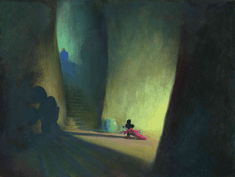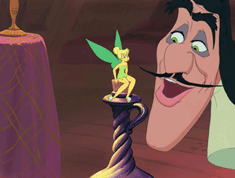  |
|
Radio-Canada invites you to tune in for Le Merveilleux Monde de Disney +
Walt Disney at the Museum?The Sources of Inspiration for the Disney Studios
After its presentation at the Grand Palais in Paris, where it was a huge success, the exhibition Once upon a Time Walt Disney is arriving at the Montreal Museum of Fine Arts, its only stop in North America, from March 8, to June 24, 2007. Walt Disney at the Museum? If the question is being raised at the outset, it is because this exhibition project has occasionally been greeted with a puzzled smiles. Indeed, how can one explain the admission of Walt Disney (1901–1966) ) and his group of characters, from Mickey to Mowgli, to the museum where undisputed masters such as Nicolas Poussin, Édouard Manet and Pablo Picasso have been celebrated for close to 150 years? Regarded by some as a paragon of mawkishness and popular entertainment, by others as a storyteller of genius, Disney’s entry into the museum elevates him de facto to the ranks of great artists in the history of Western art, where some will undoubtedly fail to understand his presence. For the author of these lines, the answer is, as one might expect, obvious and a firm belief: Walt Disney belongs alongside the most important figures of cinema and, more generally, twentieth-century art. To that end, the exhibition establishes for the first time a parallel between the original drawings of The Walt Disney Studio and the works of Western – and sometimes other – art that inspired them, from the Gothic Middle Ages to Surrealism. The art of Gustave Doré, Daumier, the German Romantic painters, Symbolists and English Pre-Raphaelites, as well as Early Flemish painters and Expressionist film, profoundly influenced the Disney Studios’ productions.
From the mid-1930s, Walt Disney gathered all the information he could on European artists whose style could be relevant to his projects. And when his own skills were no longer sufficient, he had the wit to hire artists whose knowledge was far wider than his own, and who were for the most part immigrants from Europe. Almost all of these artists were trained at European academies and brought with them not only technical mastery of their art, whether in painting, drawing, sculpture or illustration, but also the whole aesthetic tradition and artistic heritage of their respective countries. And certain American-born artists brought together by Disney were no less talented. The personality of these artists alone would help to explain the richness of Disney’s sources. Throughout his life, Disney remained interested in technological innovation. He also grasped the importance of European literature and fairytales as inspiration for his short films. With advice from his artists, he then began to acquire books – which from 1934 on would act as the Studio’s working library – while at the same time deciding to produce his first feature-length venture, Snow White and the Seven Dwarfs, based on fairy tale by the Brothers Grimm. He kept buying more and more books, until the summer of 1935, when he set off on a major trip around Europe. This visit had a decisive influence on the make-up of his documentary treasurehouse and the subsequent creations of the Disney Studios. Together with members of his family, Disney spent eleven weeks in France, Italy, Switzerland, England and Holland. He bought some three hundred and fifty books, all of them for the Walt Disney Studio Library. His selection included all the great European illustrators of the day: Arthur Rackham, Gustave Doré, Honoré Daumier, Grandville, Benjamin Rabier, Ludwig Richter, Wilhelm Busch, Heinrich Kley, Attilio Mussino, John Tenniel, Charles Folkard and many others. This phenomenal richness of Walt Disney’s sources and inspiration is what the present exhibition attempts to shed light on.
The exhibition concentrates on the animated feature films produced under Walt Disney’s personal supervision, i.e. from Snow White and the Seven Dwarfs (1937) to Jungle Book (1967), released almost one year after his death in December 1966. From this corpus, a history of Disney’s sources of inspiration can be pieced together, the works illustrating the connections between scholarly and popular culture, old Europe and America as well. The exhibition starts with Walt Disney’s first steps and the creation of the Mickey Mouse character, paying tribute to the man and his main artistic collaborators. The following sections are dedicated to the literary and film sources, then the sources for the sets and the architecture. Another section is dedicated to the theme of anthropomorphism, which is central to Disney’s oeuvre. Further on, the genesis of the main Disney characters is explained film by film, from Snow White to 101 Dalmatians. Finally, the exhibition concentrates on the influences of Disney productions on contemporary art, from Warhol to Lichtenstein, thus rounding off the survey of this constant back-and-forth between the cultures and their manifestations.
Although the exhibition emphasizes Disney’s European sources, one must not forget the significant role played by the purely American models – Hollywood movies often provided models for Disney characters, from Chaplin and Douglas Fairbanks to Joan Crawford, Shirley Temple and Jean Harlow. Disney had no qualms about borrowing from various and seemingly conflicting sources: Shakespeare and vaudeville, avant-garde and popular films, classical painting and children’s illustrations, Stravinsky and harmonicas. This unlikely blend became a unique and revolutionary form of expression, the expression of a wonderful image recycler and one of the greatest of storytellers, an artist in a class all his own. Although he cannot be considered as the inventor of the cartoon, he was the first to give it such careful artistic treatment: the quality of the Disney Studios’ drawings is one of the discoveries of this exhibition. While this genre had been in danger of remaining an avatar of cinema (itself long relegated to the rank of a minor art), Walt Disney’s perfectionism and genius thus provided the cartoon with a universal audience. Bruno Girveau, Chief Curator of the exhibition |
||||||||
|
Claude Coats; Fantasia: The Sorcererís Apprentice (Detail); 1940; Preliminary study; Oil on paper; Burbank, California, Walt Disney Feature Animation and the Animation Research Library; © Disney Enterprises, Inc. |

 Click to enlarge
Click to enlarge

